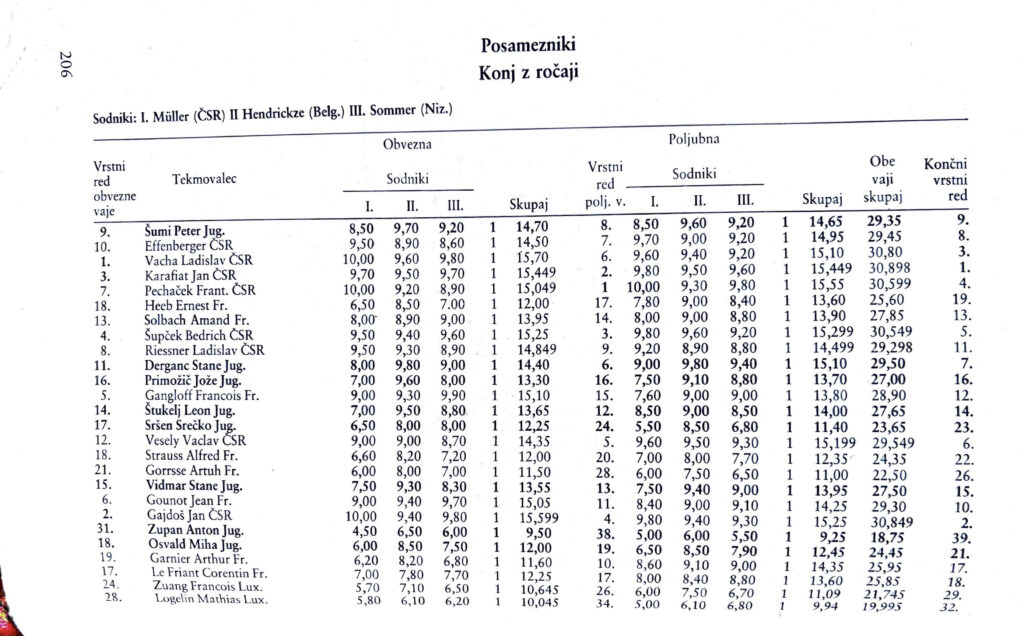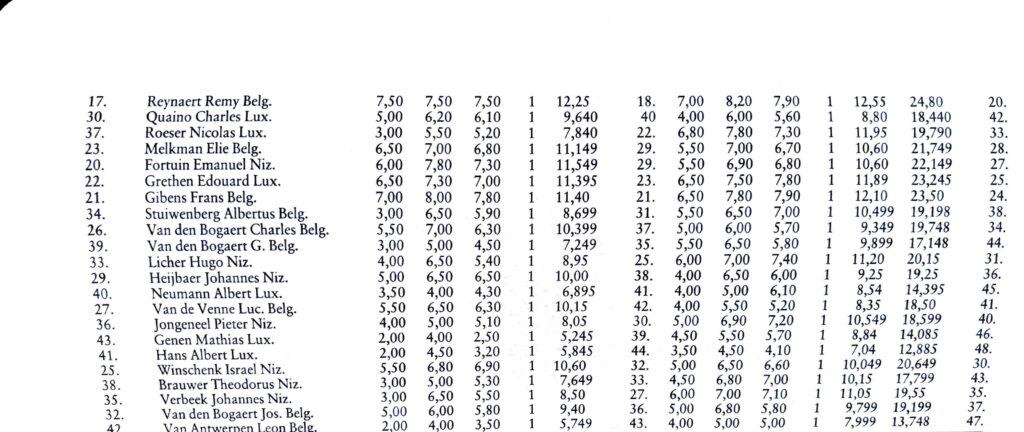Coming into the 1926 International Tournament in Lyon, France, the Czechoslovak team had won three consecutive team titles at the International Tournament (1911, 1913, and 1922). Plus, they had won the team title at the 1924 Olympic Games in Paris. So, the 1926 World Championships (called the International Tournament at the time) were an opportunity to further demonstrate their superiority.
Here’s a quick summary of what happened on May 22 and 23, 1926, in Lyon, France.
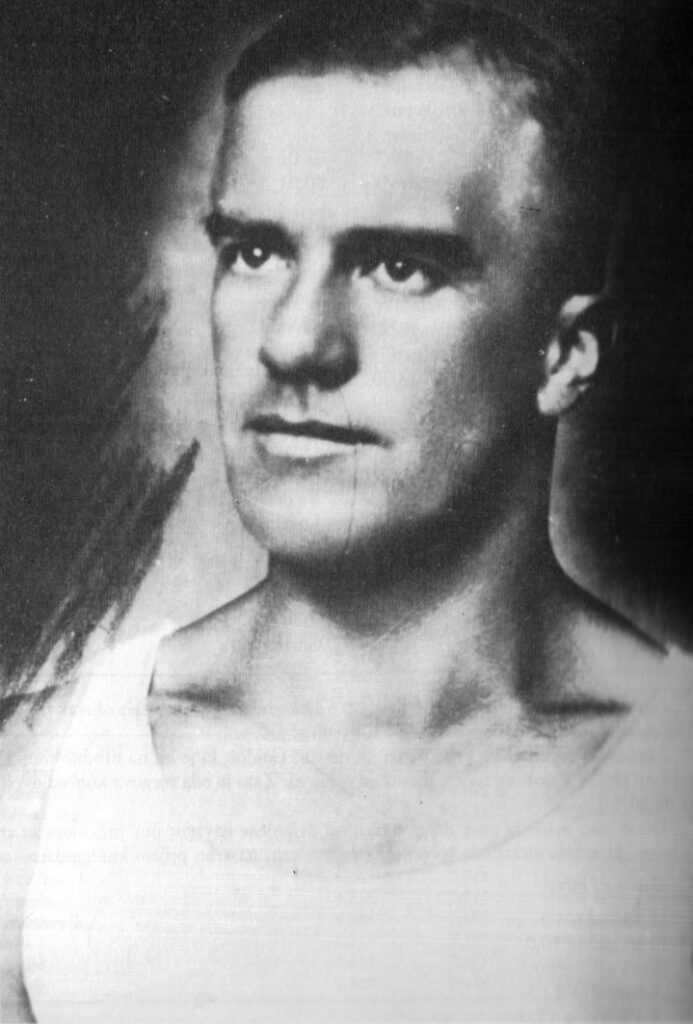
Events | Rules and Scoring | Results | Competition Commentary | Appendix A: All-Around Results: 21-48 | Appendix B: Every Score from Every Judge
The Events
Ensemble Routines:
- 3 compulsory routines (without portable hand apparatus)
Compulsory Routines:
- Pommel Horse
- Rings
- Parallel Bars
- High Bar
Optional Routines:
- Pommel Horse
- Rings
- Parallel Bars
- High Bar
Track and field:
- 100m
- 0 points: 15 ⅘ seconds
- 15 points: 11 seconds
- High jump
- 0 points: 1.10 m (3’7.31”)
- 15 points: 1.70 m (5’6.93”)
- Shot put, alternating arms
- 1 point: 12.50 m total (41’0.13”)
- 15 points: 19.50 m total (63’11.72”)
Other:
- Rope climb 8m
- 0 points: 14 seconds
- 15 points: 8 seconds
- 50 m freestyle swim
- 0 points: 75 seconds
- 15 points: 36 seconds
Source for time and distance scales: Štukelj, Mojih sedem svetovnih tekmovanj
The last time flying rings were used at a major men’s competition.
The apparatus gymnastics was of the same type as in previous tournaments; on the rings, however, we saw a team — for the last time — doing apparatus gymnastics on swinging apparatus (Netherlands).
Olympische Turnkunst, October 1967
Das Gerätturnen hatte die gleiche Art wie in den letzten Turnieren; an den Ringen aber sahen wir bei einer Mannschaft — zum letzten Male — ein Gerätturnen am schaukelnden Gerät (Niederlande).
The scale for the athletics portion was extremely challenging. No one received the maximum number of points.
Here were the top scores:
- High Jump: Gajdoš, TCH, 1.60 m, 12.50 points
- Shot Put: Pecháček, TCH, 19.04 m, 14.10 points
- Right: 9.935 m
- Left: 9.105 m
- Rope Climb: Šumi, YUG, 9.0 sec., 12.50 points
Gorisse, FRA, 9.0 sec., 12.50 points - 100 m: Strauss, FRA, 11.2 sec., 13.00 points
- Swim: Van de Venne, BEL, 44.4 sec., 10.60 points
Source: Štukelj, Mojih sedem svetovnih tekmovanj
The Rules and Scoring
The Big Rule Change
6-8 gymnasts per team. Only the top six all-around scores counted.
Each team consists of eight (or seven) competitors who will participate in all prescribed events. The top six points count towards the final result. The competitor or both who received the worst scores are excluded from the team (i.e. they become substitutes).
Sokol, 1926, 1
Každé družstvo sestává z osmi (neb sedmi) závodníků, kteří zúčastní se všech předepsaných závodních druhů. Do konečného výsledku počítají se body šesti nejlepších. Závodník nebo oba, kteří obdrželi nejhorší známky, se z počtu vylučují (t. j. stávají se náhradníky).
Note: At the 1913 and 1922 World Championships, teams had six designated gymnasts with one or two substitutes competing alongside them. The scores of the substitutes counted only if one of the six main athletes had to drop out. In this new format, the teams could have up to 8 gymnasts competing at one time without naming their top 6 gymnasts ahead of time. At the end of the competition, the top six scores counted.
The Scoring
Ensemble calisthenics: 10 points per gymnast per exercise, plus 20 points for the overall performance
Apparatus: 15 points per exercise per gymnast, plus 1 point for the presentation (0.5 for the approach and 0.5 for leaving the apparatus).
Behavior: 10 points for the overall behavior of the team.
Punctuality: 20 points (5-point deduction for every 15 minutes of delay).
Athletics: 15 points
Note: The 20 points for punctuality and the points for the approach and departure were part of the 1924 Olympics, too.
Source: Olympische Turnkunst, October 1967
The Results
Note: You can click on the result tables and scroll to the right to see the rest of the data.
Team Results
| 1. TCH | 2. YUG | 3. FRA | 4. LUX | 5. BEL | 6. NED | |
| Prelim. Exercises | 185.910 | 191.690 | 186.030 | 183.070 | 169.940 | 157.920 |
| Parallel Bars | 170.342 | 172.827 | 171.950 | 135.790 | 143.460 | 132.989 |
| HighBar | 178.191 | 181.750 | 178.250 | 146.819 | 128.549 | 95.210 |
| Pommel Horse | 181.594 | 164.650 | 158.500 | 118.670 | 127.496 | 119.995 |
| Rings | 180.860 | 185.450 | 180.600* | 155.793 | 143.000 | 119.593 |
| High Jump | 61.250 | 51.750 | 50.500 | 43.750 | 37.500 | 42.50 |
| Shot Put | 62.100 | 61.500 | 43.700 | 44.800 | 14.900 | 33.90 |
| Rope Climb | 55.000 | 36.500 | 52.500 | 19.000 | 15.800 | 10.00 |
| 100 m | 57.500 | 48.750 | 68.000 | 46.750 | 40.000 | 50.000 |
| 50 m Swim | 38.050 | 40.500 | 24.200 | 9.750 | 28.350 | 30.90 |
| Behavior | 8.000 | 8.000 | 8.000 | 8.000 | 8.000 | 7.500 |
| Punctuality | 20.000 | 20.000 | 20.000 | 20.000 | 20.000 | 20.000 |
| Total | 1,159.957 | 1,152.023 | 1,020.773 | 932.192 | 876.995 | 820.507 |
*Note: According to Štukelj, the FIG results sheet lists 190.600 as France’s rings total, but the math indicates that it was 180.600.
Several teams canceled at the last minute.
Italy, Switzerland, England, and Sweden canceled their participation just before the competition.
Sokolski Glasnik, 1926, 10-11
Odkazali su učestvovanje tik pre utakmicu Italija, Švicarska, Engleska i Švedska.
The Yugoslavs saw the results as a victory for the Slavs.
We can proudly point out that the Slavic gymnastics system won in Lyon, scientifically conceived by the genius spirit of the esthete, historian and philosopher Miroslav Tyrš.
Sokolski Glasnik, 1926, 10-11
Sa ponosom lahko istalcnemo, da je u Lyonu pobedio slavenski telovežbački sustav, kojega je znanstveno zamislio ženijalni duh esteta, istorika i filozofa Miroslava Tyrša.
The All-Around Results
Note: The preliminary calisthenics were not included in the all-around score. (They were included in 1922.)
| Name | Country | High Bar | Parallel Bars | Rings | Pommel Horse | Shot Put | High Jump | Rope Climb | 100 m | 50 m Swim | Total |
| 1. Šumi, Peter | YUG | 30.600 | 27.900 | 31.100 | 29.350 | 9.300 | 8.750 | 12.500 | 9.250 | 9.800 | 168.550 |
| 2. Effenberger, Josef | TCH | 29.149 | 26.697 | 29.240 | 29.450 | 12.000 | 11.250 | 9.500 | 9.500 | 9.500 | 166.288 |
| 3. Vácha, Ladislav | TCH | 31.348 | 31.248 | 31.750 | 30.800 | 11.800 | 10.000 | 9.500 | 9.500 | 0.000 | 165.945 |
| 4. Karafiát, Jan | TCH | 29.598 | 28.428 | 29.340 | 30.898 | 8.900 | 7.500 | 11.500 | 9.250 | 9.200 | 164.614 |
| 5. Pecháček, František | TCH | 30.098 | 28.149 | 28.250 | 30.599 | 14.100 | 11.25 | 4.000 | 9.750 | 7.800 | 163.996 |
| 6. Heeb, Ernest | FRA | 29.750 | 29.400 | 31.500 | 25.600 | 9.800 | 8.750 | 9.50 | 12.00 | 7.400 | 163.700 |
| 7. Solbach, Armand | FRA | 30.400 | 29.750 | 31.200 | 27.850 | 10.500 | 9.250 | 8.500 | 12.000 | 3.650 | 163.100 |
| 8. Šupčík, Bedřich | TCH | 29.299 | 28.199 | 31.530 | 30.549 | 7.200 | 10.000 | 11.500 | 9.750 | 4.250 | 162.277 |
| 9. Riesner, Ladislav | TCH | 28.699 | 27.298 | 30.750 | 29.298 | 8.100 | 11.250 | 9.00 | 9.750 | 7.300 | 161.445 |
| 10. Derganc, Stane | YUG | 29.100 | 28.484 | 30.550 | 29.500 | 11.900 | 6.250 | 4.000 | 7.500 | 10.300 | 157.584 |
| 11. Primožič, Jože | YUG | 31.550 | 29.299 | 31.150 | 27.000 | 9.700 | 10.000 | 7.000 | 5.250 | 5.600 | 156.549 |
| 12. Gangloff, François | FRA | 29.650 | 28.650 | 29.400 | 28.900 | 8.800 | 7.500 | 6.500 | 9.750 | 5.800 | 154.950 |
| 13. Štukelj, Leon | YUG | 31.600 | 30.450 | 31.850 | 27.650 | 7.200 | 8.750 | 3.500 | 8.500 | 5.300 | 154.800 |
| 14. Sršen, Srečko | YUG | 29.950 | 29.1950 | 31.200 | 23.650 | 12.6000 | 10.500 | 8.000 | 9.250 | 0.000 | 154.345 |
| 15. Veselý, Václav | TCH | 29.248 | 28.349 | 30.080 | 29.549 | 8.400 | 8.750 | 4.000 | 8.500 | 6.900 | 153.776 |
| 16. Straus, Alfred | FRA | 30.400 | 29.900 | 29.500 | 24.350 | 8.900 | 7.500 | 10.000 | 13.000 | 0.000 | 153.550 |
| 17. Gorisse, Artur | FRA | 28.150 | 27.100 | 28.400 | 22.500 | 8.300 | 8.750 | 12.500 | 12.000 | 5.200 | 152.900 |
| 18. Vidmar, Stane | YUG | 28.950 | 27.499 | 29.600 | 27.500 | 10.800 | 7.500 | 1.500 | 9.000 | 9.500 | 151.849 |
| 19. Gounot, Jean | FRA | 29.900 | 27.150 | 30.600 | 29.300 | 7.400 | 8.750 | 5.500 | 9.250 | 2.150 | 150.000 |
| 20. Gajdoš, Jan | TCH | 29.149 | 30.598 | 30.540 | 30.849 | 5.400 | 12.500 | 0.000 | 9.750 | – | 148.786 |
For Yugoslavia, Šumi’s first-place finish was a big deal because he didn’t have to share the gold as he did in 1922. (Note: The all-around gold was the only individual medal given out.)
Peter Šumi with 168.55 points first!
This is his second big success, even bigger than four years ago in Ljubljana, because he is now even 2.262 points ahead of second-placed Czech Effenberger, while in Ljubljana he had to share his first place ex aequo with Czech Pecháček.
As the International Gymnastics Federation awarded only first place in the all-around with a gold medal, he received the second gold medal with this success.
Unlike, as was the custom at the Olympics, no awards were given for any other place in similar competitions, whether it be in the all-around or in other disciplines.
Štukelj, Mojih sedem svetovnih tekmovanj
Peter Šumi s 168,55 točke prvi!
To je njegov drugi veliki uspeh, še večji kot pred štirimi leti v Ljubljani, ker je sedaj celo za 2,262 točke pred drugouvrščenim Čehom Effenbergerjem, medtem ko je moral v Ljubljani deliti svoje prvo mesto ex aeguo S Čehom Pechačkom.
Ker je Mednarodna telovadna zveza nagrajevala le prvo mesto v mnogoboju z zlato kolajno, je prejel s tem uspehom že drugo zlato kolajno.
Z razliko, kot je bil običaj pri olimpijskih igrah, niso bila pri podobnih tekmah podeljevana priznanja za katerokoli drugo mesto, bodisi v mnogoboju bodisi v drugih disciplinah.
The Perfect Scores
| Gymnast | Country/Team | Score | Event |
| Leon Štukelj | Yugoslavia | 16.0 | Rings Optionals |
Note: Leon Štukelj received three 10s for his optional routine on high bar. However, he received only 0.90 for his mount and dismount. So, his final score of 15.90 was not quite perfect.
Competition Commentary
The Lead-up to the Competition
In the lead-up to the competition, the Czech team was concerned about high bar, specifically the challenges of chalking:
The bar in recent competitions has always been a dreaded piece of equipment for us. Same for us, the competitors, and the leaders. […] A lot of uncertainty on the high bar was caused by the “double lubrication” in practice. One of the brothers used magnesium, the others again rosin. They both together don’t work on one rail.
Sokol, 1926, 1
Hrazda v posledních závodech byla pro nás vždycky nářadím obávaným. Od nás, závodníků, i od vůdců. […] Mnoho nejistoty na hrazdě zavinilo »dvojí mazání« V nácviku. Jedni z bratří užívali magnesia, druzí opět kalafuny. Obé na jedné hrazdě neobstojí. Čelilo se tím, že stavěly se v nácviku hrazdy dvě.
Meanwhile, the Slovenian team was unsure if it would have the finances to send a team.
A few months before the match, it was not known whether he would allow financial resources to participate at an international match. Due to that, the preparations were insignificant, and only accelerated at the last moment.
Sokolski Glasnik, 1926, 10-11
Nekoliko meseci pre utakmicu nije se znalo, hoče li dopustiti finansijska sredstva učeslvovanje na medunarodnoj utakmici. Radi toga bile su i pripreme neznatne, a tek u poslednjem trenutku pospešene.
The Dutch were pessimistic going into the competition. After a public display, one newspaper claimed that the country’s apparatus gymnastics had not improved in 20 years.
Our apparatus gymnastics has not improved, especially in recent years, compared to some twenty years ago, and we naturally wish them all the success that our people hope to have in Lyon, but we doubt that they will be among the stars.
De Maasbode, May 20, 1926
Ons toestelturnen is voornamelijk de laatste jaren er niet op vooruit gegaan, vergeleken bij een twintigtal jaren terug en het succes dat de onzen in Lyon hopen te hebben, wenschen wü hun natuurlijk van harte toe, doch dat zij onder de uitblinkers zullen behooren, betwijfelen wij ten zeerste.
In fact, one newspaper called their gymnastics “anything but safe.”
Beautiful apparatus gymnastics were shown now and then, but the failures that occurred in almost every exercise gave the overall impression of it being anything but safe.
Het Volk, May 20, 1926
Wel werd er nu en dan mooi toestelturnen te zien gegeven, doch de mislukkingen die bijna bij iedere oefening voorkwamen, gaven het geheel een allesbehalve veiligen indruk.
The Competition
The Dutch team struggled with the third exercise during the preliminary calisthenics. They felt that their style wasn’t appreciated by the judges.
The draw determined that the Netherlands would work number three. Started with free practice. The Dutch team, led by Metz, defends itself bravely in the first and second exercise. A few mistakes were made in the third, which no doubt saved the division a place. Also, the vigorous way of working of our boys does not seem to find undivided appreciation among the international jury, compared with, we might almost say, the careful work of all other countries.
De Avondpost, May 27, 1926
De loting bepaalde, dat Nederland nummer drie zou werken. Begonnen werd met vrije oefening. De Nederlandsche ploeg, onder aanvoering van Metz, weert zich dapper bij de eerste en tweede oefening. Bij de derde werden een paar vergissingen gemaakt, wat de afdeeling ongetwijfelt een plaats scheelt. Ook schijnt bij de internationale jury de forsche wijze van werken onzer jongens, vergeleken met, we zouden haast zeggen, het voorzichtige werk van alle andere landen geen onverdeelde waardeering te kunnen vinden.
Vácha, Strauss, and Sršen tried to swim, even though they couldn’t.
Of the eleven competitors who did not receive any scores, three tried to swim, namely Vacha, Strauss and Sršen, and eight did not try to swim.
Štukelj, Mojih sedem svetovnih tekmovanj
Od enajst tekmovalcev, ki niso prejeli nobene ocene, so trije poskulsili plavati, in sicer Vacha, Strauss in Sršen, osem pa se jih ni javilo k plavanju.
In fact, Sršen started to drown.
It still chills me when I think of swimming.
We swam in some pond in the park; the heat of the water was 11 degrees. The day was cloudy and gloomy. Wrapped in black capes, we shivered from the cold and anticipation, I almost rushed into the water in despair.
The hero was Sršen. Although he could not swim, he jumped into the water and splashed in it for a while, until he began to drown. That’s when they pulled him out. He thus fulfilled his sporting duty.
Štukelj, Mojih sedem svetovnih tekmovanj
Še sedaj me zazebe, če pomislim na plavanje.
Plavali smo v nekem ribniku v parku; toplota vode je bila 11 stopinj. Dan je bil oblačen in mrk. Zaviti v črne pelerine smo se od mraza in pričakovanja tresli, Skoro v obupu sem se pognal v vodo.
Junak je bil Sršen. Čeprav ni znal plavati, je skočil v vodo in v njej nekaj časa čofotal, dokler se ni začel utapljati. Takrat so ga potegnili ven. Svojo športno dolžnost je s tem izpolnil.
Vácha somehow finished third in the all-around, even though he couldn’t swim.
Czech Vácha proved to be especially good […]. In the further competition, he proved that he was an excellent versatile gymnast and also a good athlete, although he did not know how to swim and, like our Sršen, he received a “zero” rating in swimming. However, he was only 2.604 points behind the champion Šumi in this big gap, after Šumi received a score of 9.80 in swimming.
Štukelj, Mojih sedem svetovnih tekmovanj
Posebej se je izkazal Čeh Vacha […]. V nadaljnjem tekmovanju je dokazal, da je bil odličen vsestranski telovadec in tudi dober atlet, čeprav ni znal plavat in je, tako kot naš Sršen, prejel v plavanju oceno »nič«. Vseeno pa je zaostal za prvakom Šumijem ob tej veliki vrzeli le za 2,604 točke, potem ko je Šumi prejel v plavanju oceno 9,80.
Note: Štukelj had some thoughts on Vácha’s third-place finish. See the comments on judging below.
Looking at the scores years later, Štukelj thought that the Czech judges were biased against the Yugoslav gymnasts.
For example, Havel on parallel bars…
The third judge on the parallel bars was the Czech judge Havel.
If we delve a little deeper into his scoring technique, we see that he consistently rated the Czech competitors better, and corrected or leveled us and others who were closer to the top, so that there were significant differences.
Derganc, Primožič, Šumi, Sršen, and I were scored lower than the other two judges on the compulsory routines, and in the optional exercises, he made an exception only for Sršen compared to the first judge.
Here we can find for the first time the evaluation tactics of the Czech judges, which continued on other tools or disciplines in this competition and, as we will see, also on later ones.
Štukelj, Mojih sedem svetovnih tekmovanj
Tretji sodnik na bradlji je bil češki sodnik Havel.
Če se mal poglobimo v njegovo tehniko ocenjevanja, vidimo, da je dosledno bolje ocenjeval češke tekmovalce, nas in druge, ki so bili bolj pri vrhu, pa nižje ocene popravljal oziroma izravnaval, tako da so nastajale precejšnje razlike.
Dergancu, Primožiču, Šumiju, Sršenu in meni je obvezno vajo ocenil nižje kot druga dva sodnika, v poljubni vaji pa je naredil izjemo samo pri Sršenu glede na prvega sodnika.
Tu lahko prvič ugotovimo ocenjevalno taktiziranje čeških sodnikov, ki se je nadaljevalo tudi na drugih orodjih oziroma v disciplinah na tem tekmovanju in, kot bomo videli, tudi na kasnejših.
He noticed Müller’s inconsistencies on pommel horse
I remember that Šumi and Derganc were very upset because of Müller’s assessment, while I probably, as usual in all competitions, was not interested in them this way either, because otherwise I would have remembered it. It was only when I delved into the evaluation of this description of the competition that I realized that I was also affected, for example in the evaluation for the mandatory exercise, when Judge Miiller gave me a score of 7.00, a Belgian 9.50 and a Dutchman 8.80. . He assessed Šumija with 8.50 and the other two judges with 9.70 and 9.20.
Štukelj, Mojih sedem svetovnih tekmovanj
Spominjam se, da sta se zaradi Müllerjevega ocenjevanja zelo vznemirjala Šumi in Derganc, medtem ko se jaz verjetno, kot običajno na vseh tekmovanjih, nisem tudi to pot zanimal zanje, ker bi se drugače tega spominjal. Šele, ko sem se ob tem opisu tekmovanja poglobil v ocenjevanje, spoznavam, da sem bil tudi jaz prizadet, na primer pri oceni za obvezno vajo, ko mi je sodnik Miiller prisodil oceno 7,00, Belgijec 9,50 in Nizozemec 8,80. Šumija je ocenil z 8,50, druga dva sodnika pa z 9,70 in 9,20.
Based on the scores, Štukelj felt that the Yugoslav judges were fair, unlike the Czech judges.
If we look at how our two judges judged, Smertnik on high bar and Kuščer on rings, not only the Czech but also all the other competitors, we see that they were very objective and did not make such a difference between their assessments and those of the other two judges.
Štukelj, Mojih sedem svetovnih tekmovanj
Če pogledamo, kako sta ocenjevala naša dva sodnika, Smertnik na drogu, Kuščer pa na krogih, ne samo češke, temveč tudi vse druge tekmovalce, vidimo, da sta bila zelo objektivna in niso nastajale med njunima ocenama in ocenama drugih dveh sodnikov tolikšne razlike.
Štukelj compared his own scores with those of Vácha and concluded that the Czech judges had a hand in the difference of scores.
That the Czech judges Havel on parallel bars and Müller on pommel horse are also responsible for this difference is obvious if we look at how Vácha and I judged on these apparatus. We are not to blame the competitor for such an evaluation policy, but it is understood that every competitor wants objective evaluation, real recognition of his efforts and knowledge, which is the only payment to the competitor.
By this, however, I do not underestimate the excellent Vácha, who has proven to be a reliable and versatile gymnast two years prior in Paris.
Štukelj, Mojih sedem svetovnih tekmovanj
Da imata za to razliko tudi zaslugo češka sodnika Havel na bradlji in Miiller na konju z ročaji, je očitno, če pogledamo, kako sta ocenila na teh orodjih Vacho in mene. Tekmovalca za takšno ocenjevalno politiko nisva kriva, razume pa se, da si vsak tekmovalec želi objektivno ocenjevanje, resnično priznanje njegovemu trudu in znanju, kar je edino plačilo tekmovalcu.
S tem pa nikakor ne podcenjujem odličnega Vacha, ki se je izkazal kot zanesljiv in vsestraski telovadec že dve leti prei v Parizu.
Note: Here’s how the Czech judges evaluated Vácha and Štukelj.
| Vácha | Štukelj | |
| Parallel Bars – Comp. | ||
| De Wallens – BEL | 9.30 | 9.60 |
| Plumer – NED | 9.40 | 9.60 |
| Havel – TCH | 10.00 | 9.50 |
| Parallel Bars – Opt. | ||
| De Wallens – BEL | 9.80 | 9.20 |
| Plumer – NED | 10.00 | 9.80 |
| Havel – TCH | 10.00 | 9.20 |
| Pommel Horse – Comp. | ||
| Müller – TCH | 10.00 | 7.00 |
| Hendrickze – BEL | 9.60 | 9.50 |
| Sommer – NED | 9.80 | 8.80 |
| Pommel Horse – Opt. | ||
| Müller – TCH | 9.60 | 8.50 |
| Hendrickze – BEL | 9.40 | 9.00 |
| Sommer – NED | 9.20 | 8.50 |
Note: When it comes to the non-Czech competitors, Müller was ruthless when scoring many of the compulsory pommel horse routines. For example, he gave Ernest Heeb of France a 6.50 while his fellow judges gave him an 8.50 (BEL) and a 7.00 (NED). You can see the scores given by every judge below.
Note #2: If there was any bad blood between the Czechoslovak and Yugoslav teams, it didn’t manifest itself in the judging two years later. In 1928, a Yugoslav judge reportedly tried to help the Czechoslovak team by judging the Swiss gymnasts harshly on vault.
Appendix A: All-Around Results: 21-48
| Gymnast | Country | High Bar | Parallel Bars | Rings | Pommel Horse | Shot Put | High Jump | Rope Climb | 100 m | 50 m Swim | Total |
| 21. Zupan, Oton | YUG | 29.300 | 24.894 | 25.300 | 18.750 | 12.500 | 10.000 | 12.000 | 9.000 | 6.800 | 148.544 |
| 22. Osvald, Miha | YUG | 29.975 | 26.250 | 31.500 | 24.450 | 7.800 | 3.750 | 8.000 | 9.250 | 5.300 | 146.275 |
| 23. Gavnier, Artur | FRA | 31.150 | 30.250 | 30.250 | 25.950 | 6.200 | 6.250 | 3.000 | 11.000 | 1.900 | 145.950 |
| 24. Le Friant, Corentin | FRA | 26.475 | 23.650 | 23.950 | 25.850 | 8.600 | 10.000 | 7.500 | 10.000 | 7.300 | 143.3200 |
| 25. Logelin, Mathias | LUX | 27.574 | 22.948 | 25.698 | 19.995 | 7.600 | 7.500 | 5.000 | 9.500 | – | 125.815 |
| 26. Reynaert, Remy | BEL | 24.873 | 25.340 | 23.190 | 24.800 | 4.500 | 7.500 | 0.000 | 8.000 | 6.200 | 124.403 |
| 27. Zuang, François | LUX | 27.849 | 24.098 | 25.850 | 21.745 | 7.200 | 6.250 | 1.500 | 5.250 | 4.200 | 123.942 |
| 28. Quaino, Charles | LUX | 26.299 | 24.348 | 26.998 | 18.440 | 5.100 | 7.500 | 6.000 | 7.500 | – | 122.185 |
| 29. Roeser, Nicolas | LUX | 25.149 | 21.198 | 28.898 | 19.790 | 8.100 | 10.000 | 0.000 | 7.500 | 1.400 | 122.035 |
| 30. Melleman, Elie | BEL | 25.744 | 26.240 | 23.190 | 21.749 | 3.300 | 7.500 | 1.500 | 9.250 | 3.500 | 121.973 |
| 31. Fortuin, Emanuel | NED | 18.550 | 22.349 | 23.450 | 22.149 | 7.200 | 8.750 | 0.000 | 9.750 | 8.100 | 120.298 |
| 32. Grethen, Eduard | LUX | 18.423 | 23.249 | 23.150 | 23.245 | 7.100 | 6.250 | 4.000 | 9.500 | 4.150 | 119.067 |
| 33. Gibens, Frans | BEL | 22.525 | 25.880 | 26.430 | 23.500 | 1.700 | 5.000 | 0.300 | 6.000 | 2.850 | 114.185 |
| 34. Stuiwenberg, Albert | NED | 19.150 | 24.798 | 18.449 | 19.198 | 10.000 | 5.000 | 0.000 | 5.250 | 7.500 | 110.145 |
| 35. Van de Venne, Luc. | BEL | 16.474 | 23.490 | 24.690 | 18.500 | 1.400 | 7.500 | 0.000 | 6.750 | 10.600 | 109.409 |
| 36. Van den Bogaert, Jos. | BEL | 20.950 | 19.030 | 26.690 | 19.199 | 0.000 | 3.750 | 5.500 | 8.000 | 2.950 | 107.569 |
| 37. Van den Bogaert, Charles | BEL | 17.973 | 21.980 | 18.810 | 19.748 | 4.000 | 6.250 | 8.500 | 8.000 | 2.250 | 107.511 |
| 38. Licher, Hugo | NED | 16.900 | 20.348 | 17.048 | 20.150 | 4.700 | 7.500 | 7.000 | 10.000 | 3.750 | 107.396 |
| 39. Hiboer, Johannes | NED | 17.990 | 22.398 | 20.049 | 19.250 | 4.900 | 7.500 | 3.000 | 9.000 | 3.050 | 107.137 |
| 40. Neumann, Albert | LUX | 21.525 | 19.949 | 21.599 | 15.433 | 9.700 | 6.250 | 2.500 | 7.500 | – | 104.456 |
| 41. Jongeneel, Pieter | NED | 10.370 | 22.698 | 17.6480 | 18.599 | 5.300 | 7.500 | 0.000 | 8.500 | 8.500 | 99.115 |
| 42. Genen, Mathias | LUX | 13.700 | 20.450 | 19.599 | 14.085 | 10.300 | 7.500 | 0.000 | 8.500 | 4.000 | 98.134 |
| 43. Houss, Albert | LUX | 18.048 | 21.399 | 24.498 | 12.885 | 2.600 | 5.000 | 3.500 | 9.250 | 0.000 | 97.180 |
| 44. Van Antwerpen, Leon | BEL | 18.749 | 18.540 | 18.020 | 13.748 | 1.100 | 5.000 | 0.000 | 9.250 | 9.100 | 93.507 |
| 45. Winschenk, Israel | NED | 12.250 | 20.398 | 22.949 | 20.649 | 1.800 | 6.250 | 0.000 | 7.500 | 0.000 | 91.796 |
| 46. Brouwer, Theodoras | NED | 18.060 | 23.048 | 17.298 | 17.799 | 2.600 | 5.750 | 0.000 | 6.750 | 0.000 | 91.305 |
| 47. Verbek, Johannaes | NED | 15.700 | 20.249 | 17.798 | 19.550 | 4.700 | 6.250 | 0.000 | 6.750 | 0.000 | 90.997 |
| 48. Van den Bogaert, G. | BEL | 17.799 | 20.640 | 20.790 | 17.148 | 1.400 | 3.750 | 0.000 | 6.000 | 3.150 | 90.677 |
Appendix B: The Scores from All the Judges
High Bar
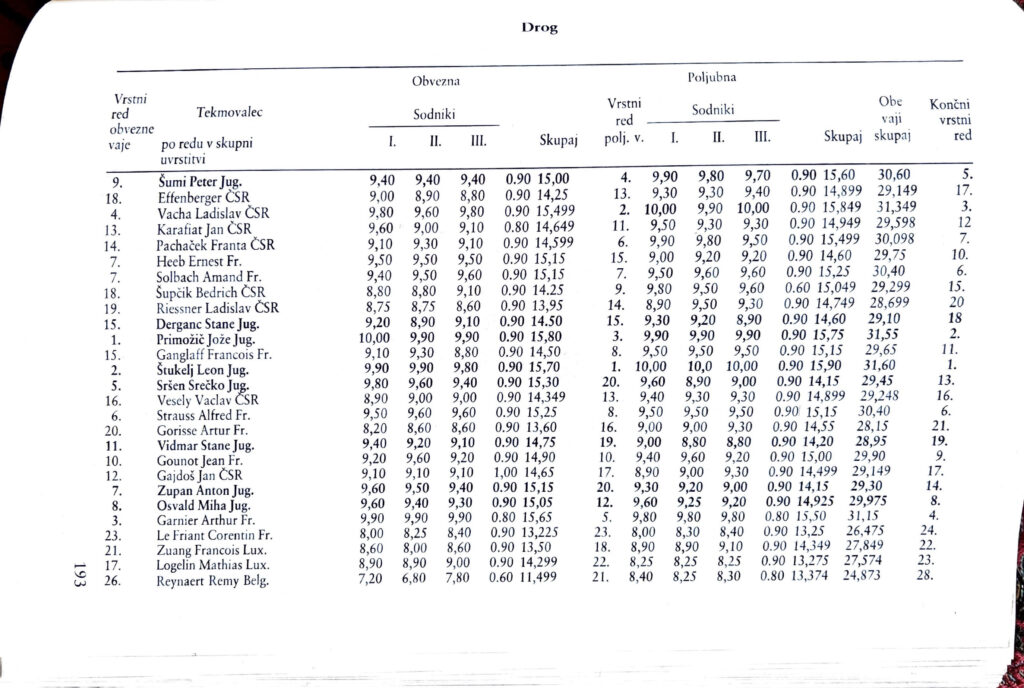
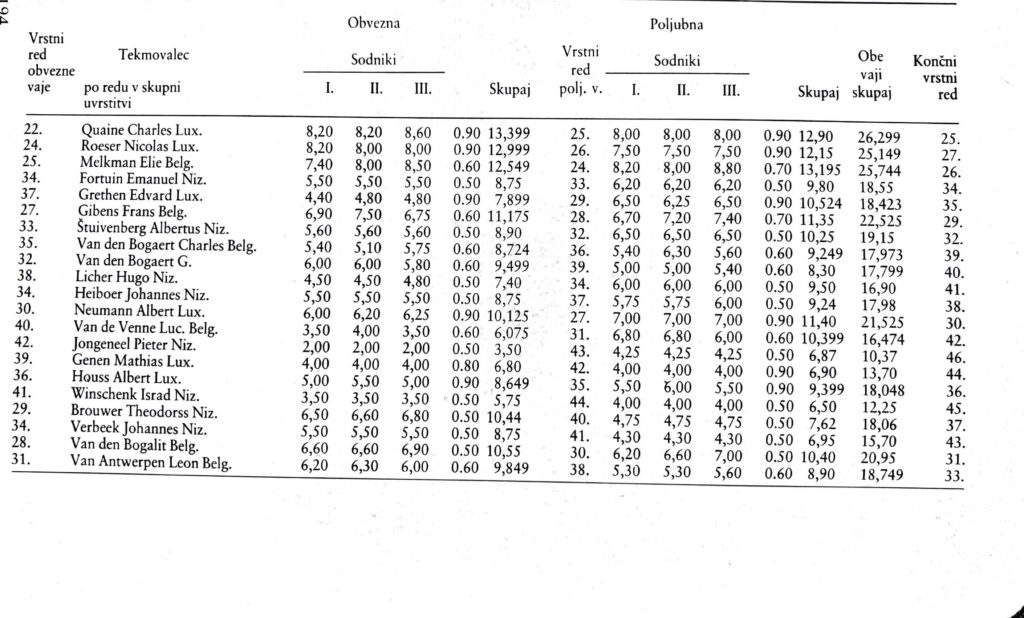
Parallel Bars
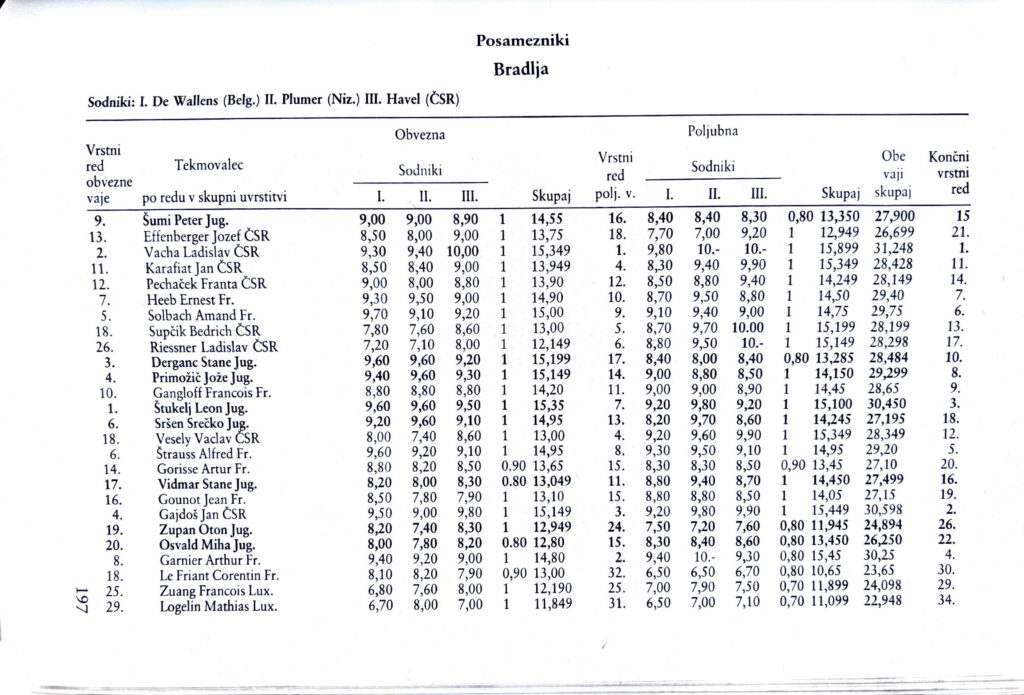
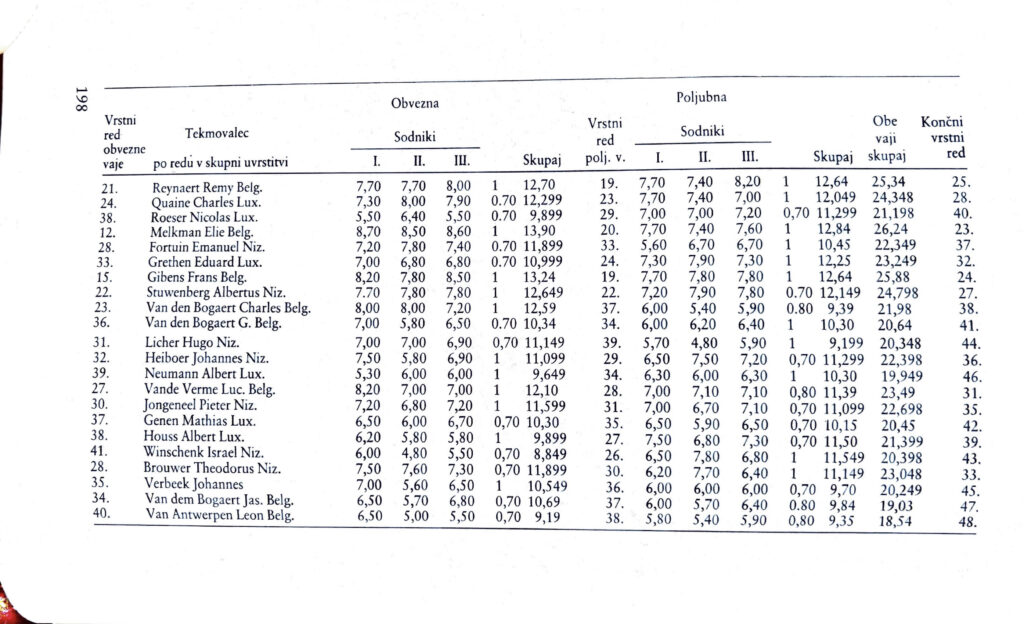
Rings
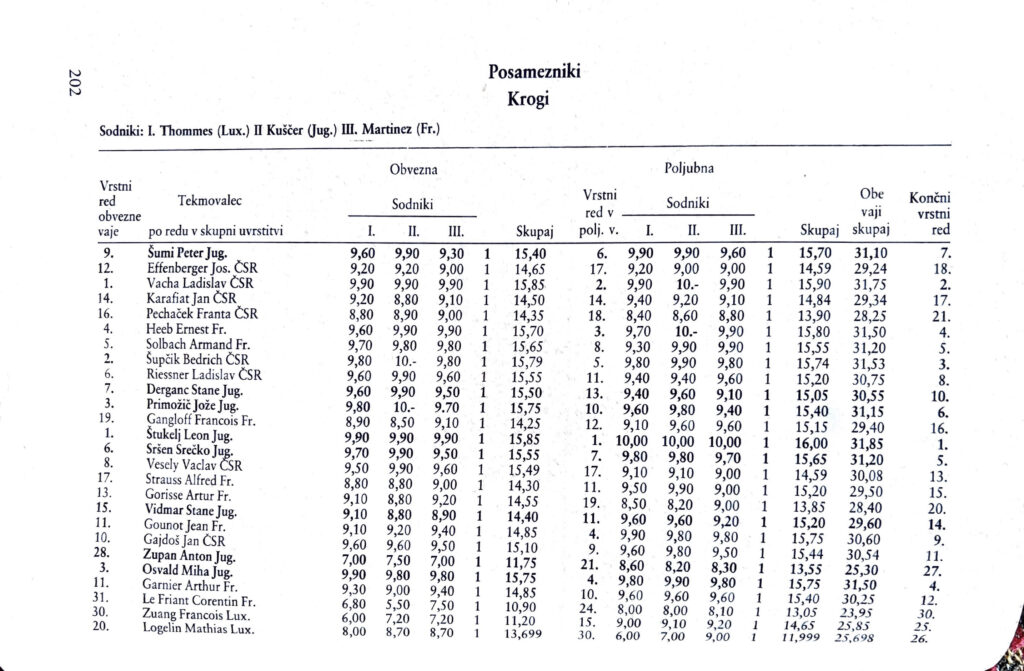
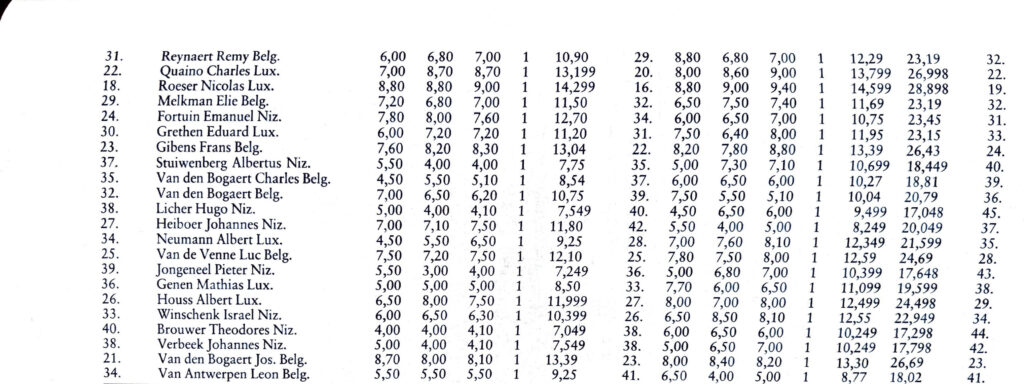
Pommel Horse
